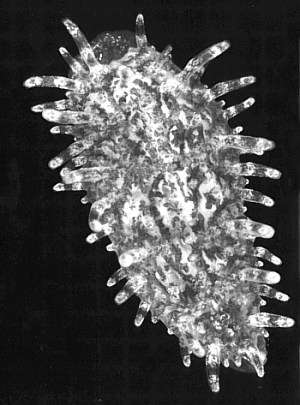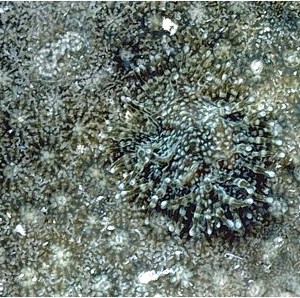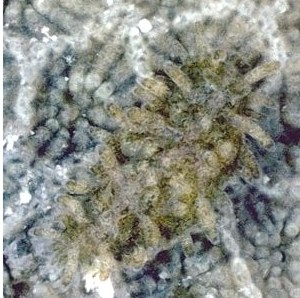
Pinufius rebus
Marcus & Marcus, 1960
Order: NUDIBRANCHIA
Suborder: ARMININA
Family: Pinufiidae
DISTRIBUTION
Tropical Indo-West Pacific
PHOTO
UPPER RIGHT: Coconut Beach, Lizard island, Great Barrier Reef, on Porites colony in 1m, June 1979, 6mm long. PHOTO: B. Goldman.
LOWER PHOTOS: Heron Is, Great Barrier Reef, Qld, June 1983: LEFT: approx 10mm, on Porites colony. Note egg mass at upper left. RIGHT: 3mm long animal on Porites. PHOTOS: Bill Rudman.
RELATED TOPIC
The animal is flattened, broadly ovate with a rounded oral veil. around the dorsal edge is an irregular double row of cerata or derata-like processes. There are also a few cerata scattered on a pattern of ridges which consist of a medial ridge and two or three transverse ridges. These ridges form a network of similar proportions to skeletal outline of the calices which support each coral polyp. Throughout the body wall are branching ducts of the digestive gland. The general body colour is translucent with the mottled colour of the digestive gland ducts predominating. As the digestive gland contains particles of the sponge colony, which the nudibranch is eating, and the zooxanthellae, it has obtained from its food, Pinufius exactly matches the colour of the part of the Porites colony on which it is presently feeding. See separate page where its symbiotic relationship with zooxanthellae is described.
The correct phylogenetic relationship of this nudibranch is still not clear. Although it has been placed by some authors in the Arminoidea, this is in many ways an act of faith, rather than based on clear evidence. In many ways it is very aeolid-like (digestive gland in cerata, single rachidian radular tooth, smooth rhinophore without pocket) but its general body shape and arrangement of the gut are more arminoidean. The lack of cnidosacs is not good evidence against an aeolid relationship as all Porites-feeding aeolids also lack a cnidosac. Similarly its radular morphology and general body shape may be a result of its unusual food and its zooxanthellae symbiosis.
References:
•Rudman, W.B. (1981) Further studies on the anatomy and ecology of opisthobranch molluscs feeding on the scleractinian coral Porites. Zoological Journal of the Linnean Society 71: 373-412.
•Rudman, W.B. (1982) The taxonomy and biology of further aeolidacean and arminacean nudibranch molluscs with symbiotic zooxanthellae. Zoological Journal of the Linnean Society 74: 147-196.


Rudman, W.B., 1999 (October 4) Pinufius rebus Marcus & Marcus, 1960. [In] Sea Slug Forum. Australian Museum, Sydney. Available from http://www.seaslugforum.net/factsheet/pinurebu
